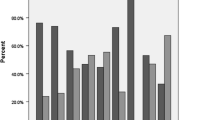Abstract
As publication pressure has increased in the world of higher education, more journals, books, and other publication outlets have emerged. Thus it is critical to develop clear criteria for effectively evaluating the quality of publication outlets. Without such criteria funding agencies and promotion committees are forced to guess at how to evaluate a scholar’s portfolio. In this article, we explore the perils of evaluating journals based on a single quantitative measure (e.g., the Impact Factor rating of the Institute for Science Information). We then discuss key considerations for evaluating scholarship, including three main criteria: rigor, impact, and prestige. Finally, we conclude with examples of how these criteria could be applied in evaluating scholarship.
Similar content being viewed by others
References
Amin, M., & Mabe, M. A. (2003). Impact factors: Use and abuse. Medicina (Buenos Aires), 63(4), 347–354.
Barbui, C., Cipriani, A., Malvini, L., & Tansella, M. (2006). Validity of the impact factor of journals as a measure of randomized controlled trial quality. The Journal of Clinical Psychiatry, 67(1), 37–40.
Bekhradnia, B. (2009). Proposals for the research excellence framework—a critique. Retrieved from the Higher Education Policy Institute website: http://www.hepi.ac.uk
Bird, H. A. (2007). Presenting and publishing research data. In H. R. H. Patel, M. Arya, & I. S. Shergill (Eds.), Basic science techniques in clinical practice (pp. 118–125). New York, NY: Springer Science + Business Media.
Blyth, E., Shardlow, S. M., Masson, H., Lyons, K., Shaw, I., & White, S. (2010). Measuring the quality of peer-reviewed publications in social work: Impact factors—liberation or liability? Social Work Education, 29(2), 120–136.
Boor, M. (1982). The citation impact factor: Another dubious index of journal quality. American Psychologist, 37(8), 975–977.
Corby, K. (2001). Method or madness? educational research and citation prestige. Portal: Libraries and the Academy, 1(3), 279–288. doi:10.1353/pla.2001.0040
D’Odorico, L. (2001). The citation impact factor in developmental psychology. Cortex, 37(4), 578–579.
Depken, C. A., & Ward, M. R. (2009). Sited, sighted, and cited: The effect of JSTOR in economic research. Unpublished manuscript. University of Texas at Arlington Working Paper.Retrieved from SSRN: http://ssrn.com/abstract=1472063
Fairbairn, H., Holbrook, A., Bourke, S., Preston, G., Cantwell, R., & Scevak, J. (2009). A profile of education journals. In P. Jeffrey (ed.) AARE 2008 Conference Papers Collection [Proceedings]. Available at http://www.aare.edu.au/08pap/fai08605.pdf. Accessed 17 Jan 2011.
Foley, J. A., & Sala, S. D. (2010). The impact of self-citation. Cortex, 46(6), 802–810.
Furr, L. A. (1995). The relative influence of social work journals: Impact factors versus core influence. Journal of Social Work Education, 31(1), 38–45.
González-Pereira, B., Guerrero-Bote, V. P., Moya-Anegón, F. (2011). The SJR indicator: A new indicator of journals’ scientific prestige. Retrieved from http://arxiv.org/ftp/arxiv/papers/0912/0912.4141.pdf
Gordge, R. (2011). Decision on assessing research impact. Higher Education Funding Council for England. Retrieved from http://www.hefce.ac.uk/research/ref/pubs/2011/01_11/
Harzing, A. (2011). Publish or perish, version 3.1.4004. Available at http://www.harzing.com/pop.htm
Haslam, N., & Laham, S. M. (2010). Quality, quantity, and impact in academic publication. European Journal of Social Psychology, 40(2), 216–220.
Hirst, G. (1978). Discipline impact factors: A method for determining core journal lists. Journal of the American Society for Information Science, 29(4), 171–172.
Holcomb, T. L., Bray, K. E., & Dorr, D. L. (2003). Publications in educational/instructional technology: Perceived values of educational technology professionals. Educational Technology, 43(5), 53–57.
Lavie, P. (2009). The race for the impact factor. Journal of Sleep Research, 18(3), 283–284.
Lee, Y., Driscoll, M. P., & Nelson, D. W. (2004). The past, present, and future of research in distance education: Results of a content analysis. American Journal of Distance Education, 18(4), 225–241.
Levine, T. R. (2010). Rankings and trends in citation patterns of communication journals. Communication Education, 59(1), 41–51.
Melby, C. S. (Ed). (2005). Examining the future of professional journals. Nursing &Health Sciences, 7(4), 219-220.
Nkomo, S. M. (2009). The seductive power of academic journal rankings: Challenges of searching for the otherwise. The Academy of Management Learning and Education, 8(1), 106–112.
Opthof, T. (1997). Sense and nonsense about the impact factor. Cardiovascular Research, 33(1), 1.
Orey, M., Jones, S. A., & Branch, R. M. (2010). Educational media and technology yearbook. Vol. 35 (illustrated ed.). New York, NY: Springer.
Rey-Rocha, J., Martín-Sempere, M. J., Martínez-Frías, J., & López-Vera, F. (2001). Some misuses of journal impact factor in research evaluation. Cortex, 37(4), 595–597.
Ritzhaupt, A. D., Sessums, C., Johnson, M. (2011, November). Where should educational technologists publish? An examination of journals within the field. Paper presented at the Association of Educational Communications and Technology, Jacksonville, Fl., USA.
Rousseau, R., & Hooydonk, G. V. (1996). Journal production and journal impact factors. Journal of the American Society for Information Science, 47(10), 775–780.
Sala, S. D., & Brooks, J. (2008). Multi-authors’ self-citation: A further impact factor bias? Cortex, 44(9), 1139–1145.
SciVerse Scopus. (2011). Content coverage guide. Retrieved from http://www.info.sciverse.com/UserFiles/sciverse_scopus_content_coverage_0.pdf
Seglen, P. O. (1997). Why the impact factor of journals should not be used for evaluating research. British Medical Journal, 314(7079), 498–502.
Sievert, M., & Haughawout, M. (1989). An editor’s influence on citation patterns: A case study of Elementary School Journal. Journal of the American Society for Information Science, 40(5), 334–341.
Taris, T. (2006). Review of “citation analysis in research evaluation.”. European Journal of Work and Organizational Psychology, 15(3), 378–382.
Tyrer, P. (2008). Practical impact? Author’s reply. The British Journal of Psychiatry, 192(1), 69.
van Driel, M. L., Maier, M., & Maeseneer, J. D. (2007). Measuring the impact of family medicine research: Scientific citations or societal impact? Family Practice, 24(5), 401–402.
Wagner, A. B. (2009, Spring). Percentile-based journal impact factors: A neglected collection development metric. Issues in Science and Technology Librarianship, 57. Retrieved from http://www.istl.org/09-spring/refereed1.html
Weingart, P. (2005). Impact of bibliometrics upon the science system: Inadvertent consequences? Scientometrics, 62(1):117–131.
Wicks, D. (2004). The institution of tenure: Freedom or discipline. Management Decision, 42(5), 619–627.
Author information
Authors and Affiliations
Corresponding author
Rights and permissions
About this article
Cite this article
West, R.E., Rich, P.J. Rigor, Impact and Prestige: A Proposed Framework for Evaluating Scholarly Publications. Innov High Educ 37, 359–371 (2012). https://doi.org/10.1007/s10755-012-9214-3
Published:
Issue Date:
DOI: https://doi.org/10.1007/s10755-012-9214-3




